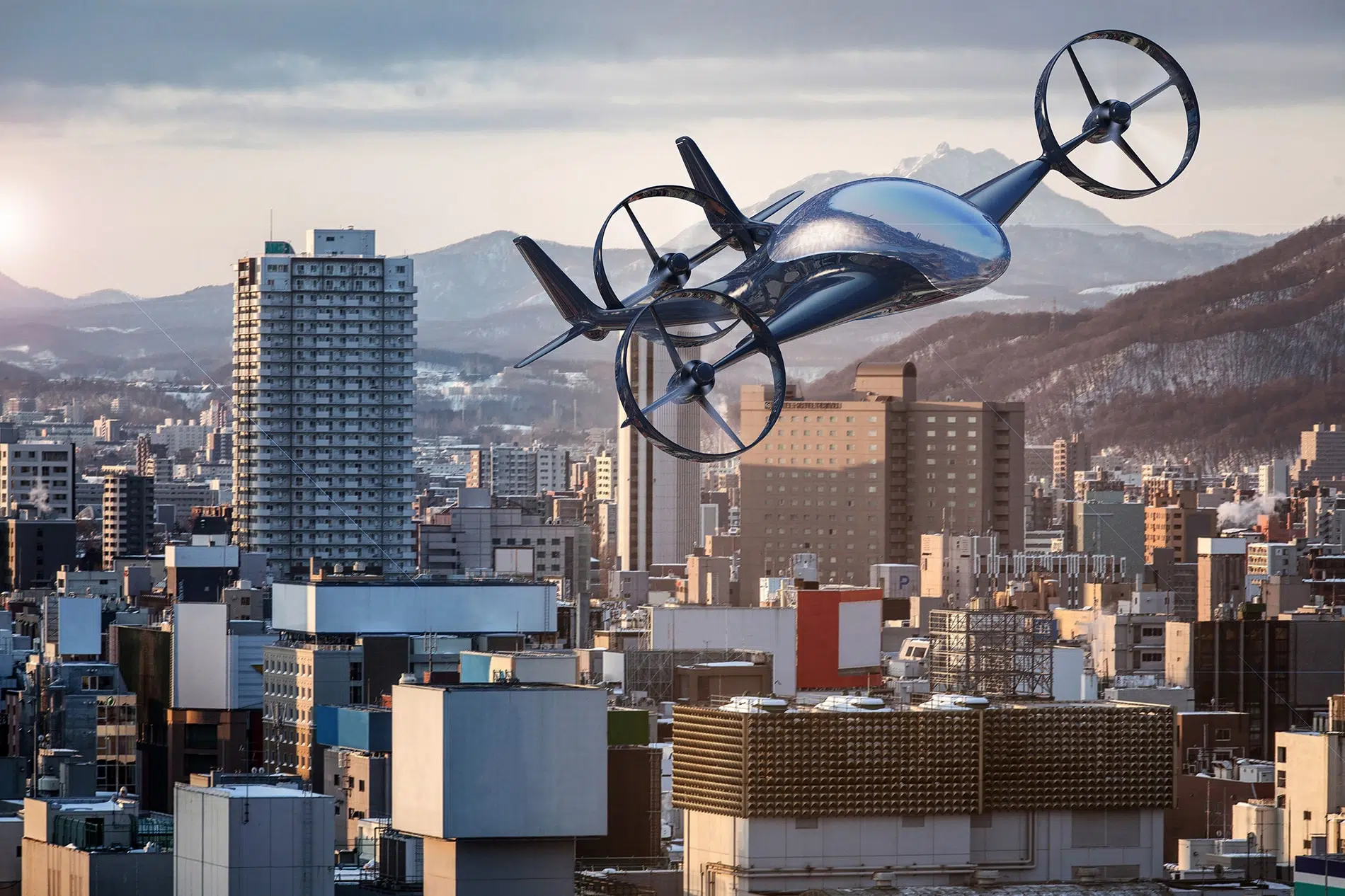- July 29, 2019
- Perspectives
Flying Cars: Looking to the Future


Douglas Gettman, Ph.D.
Smart Mobility and AV/CV Senior Consultant
From the year they’ll be commercially available to whether or not they’ll be piloted or unmanned, there’s been much discussion about flying cars. Below, Kimley-Horn’s Douglas Gettman weighs in, expanding the conversation by addressing public concerns, airspace integration, technology convergence, and more.
Will flying cars be piloted or unmanned?
Pilots will absolutely be used for commercial services at launch. Certification for automated vehicles carrying passengers without a pilot is uncharted territory for the FAA. While all commercial airplanes have autopilot software and flight assistance software, 100% of takeoffs and more than 95% of landings are still performed manually. The takeoff and landing phase of VTOL (Vertical Takeoff and Landing) craft has less risk than the equivalent phases for commercial aircraft, but it still requires control finesse, particularly in high winds. Providing air taxi service at prices that a typical consumer would pay can probably only be achieved through an automated vehicle that does not have a pilot on board, but still has a remote pilot that operates primarily as a monitor. It remains to be seen if one remote pilot will be needed for each VTOL, or if it could be possible for a remote pilot to handle multiple VTOLs at the same time. The more VTOLs that could be monitored/flown by a single operator, the cheaper the service could become. The same applies to automated taxi services on the ground. For the foreseeable future, even if there is not a driver on board, there will be someone monitoring the operation from a control center. There is already a shortage of qualified pilots for the existing aviation sector; adding additional UAM (Urban Air Mobility) services will only exacerbate the shortage, pushing the sector towards automation sooner.
What concerns might the public have with VTOLs and vertiports?
The main issue with the initial public acceptance of vertiports will be noise pollution and probably a close second will be the fear that VTOLs will be falling out of the sky and crashing into their homes. A lot of regulatory and policy work still needs to be done to identify how the VTOL routes will mitigate these kinds of concerns while meeting environmental justice and equity requirements. For example, VTOL routes will probably follow the ground highway network initially to mitigate both noise and not-in-my-backyard issues. There is still a fair portion of the population that is opposed to robotic driverless cars, so it is expected that even more of the population will be opposed to robotic, driverless VTOLs. Helicopters are slightly less safe than airplanes, particularly because planes can glide to a safe landing for many minutes if they lose power. When a helicopter loses power, it starts to drop vertically immediately, another reason for including some semblance of a fixed wing and ballistic parachutes in a VTOL design.
What airspace integration issues could we expect?
Flying taxi services will likely be most successful initially targeting short-haul business routes around 50-100 miles long. (e.g. Dallas to Fort Worth; Phoenix to Tucson; San Francisco to San Jose, etc.) and airport to tourist destinations for the affluent (e.g. Las Vegas to the Grand Canyon). These vehicles will likely have hybrid powertrains (turbines and electric) and will look more like airplanes than helicopters. Fixed wing aeronautics is about five times more efficient than helicopter rotors—which translates to lower costs. Such routes will also have fewer airspace integration issues. If these vehicles are proven to provide a niche market solution, it will provide a lot of risk buydown towards the scalability of battery production and efficiency, fuselage manufacturing, and complicated airspace deconfliction software systems necessary for a financially viable urban taxi market, which is estimated to be 10x to 100x larger than the business commuter niche. For what could be a very long time, VTOL taxis will be a service for the affluent. Remotely-piloted, automated drone VTOLs will find early success in search and rescue and public safety missions since these functions are less dependent on turning a profit.
What will this create other than being a “better helicopter”? Some say the automotive industry created the suburbs.
This is the main misconception I had about four years ago regarding what an urban air mobility vehicle actually is. As I mentioned earlier, based on first principles aeronautics, fixed-wing vehicles are about five times more efficient to keep in the air than a helicopter, so you need to spend most of the time during the flight using the wing for lift instead of tilting the vehicle nose down to get forward velocity from the rotor. If you intend to use only the rotors for lift, the batteries required will be massive to transport any appreciable payload (i.e. people and their luggage) for a distance that someone would pay to go. So, I believe commercially viable Urban Air Mobility (UAM) craft will look more like planes than helicopters and serve business travelers that need to go about 75 miles in about 15 minutes for about $100 (along with another 3-5 people from a vertiport that is probably at least 10 minutes from your house). For example, downtown L.A. to Riverside, is about 60 miles and takes at least two hours to drive. I know business travelers would spend $300 round trip to travel that distance in 45 minutes rather than driving for four hours. There are thousands of business travelers that would use such services to improve their efficiency and extend their reach to customers.
These services could eventually create more suburban sprawl if commute times were cut by 50-80%, but in the foreseeable future, this is not a service that a typical person could really afford to use for their daily commute (~$4,000/month).
What are you currently working on, what have you learned, and where do you see the future of VTOLs headed?
We are in the process of providing vertiport design services. In the near term, vertiports will be pretty pedestrian and less like what you might have seen in the Star-Wars-esque architectural renderings shown by Uber Elevate. One significant consideration at vertiports will be planning for more pick-up and drop-off space than parking; your first-mile and last-mile ground Uber will likely be part of the ticket price.
Kimley-Horn is well positioned to provide vertiport design and I think our Advanced Land Transportation Performance Simulation (ALPS) software could be pivoted to model UAM operations for service planning. Looking ahead, smart city planning and advisory services will need to include considerations for UAM. With our strong municipal relationships and understanding of municipal processes, Kimley-Horn can help the propeller enthusiasts, start-ups, and vehicle makers understand how public agencies work and how to get a project done when it involves public infrastructure, permitting, and all the mish-mash of who is responsible for what.
Is a 2023 timeline realistic?
Uber is adamant about getting a demonstration service up and running by 2023, but this will likely be one pair of vertiports and a handful of vehicles and pilots and yes, I think they’ll get there by 2023. You can’t really call that a business; it is really a proof of concept (and one heck of a cool one!). Uber’s work to identify a well-defined set of requirements (how far to go, how many people are on board, how many flights per day, etc.) has really helped the VTOL sector focus on a viable commercial mission. NASA generally has supported development of more efficient tech (higher, faster, further) or and the various branches of the military have supported development of VTOLs of various types for hauling troops and equipment.
But back to the timeline—remember in 2016 when Elon Musk said he would have a fully driverless car by 2017? And then in 2017 he said 2018, and then this year he said 2020? Same with Google/Waymo—their demo service in Chandler, Arizona still has safety drivers, when a year ago they said by this time they would be fully driverless. Getting to 90% may be considered relatively “easy” but then to get to 95% and then eventually to 100% commercial viability takes a lot of extra effort.
Achieving safe, reliable service at a profit goes way beyond just showing that a vehicle can take off with people on board and land 75 miles away in 15 minutes. Profitable services at prices the masses can afford will probably take another 10 years after 2023—that is if enough companies continue to have the capital and will to stick with the long research and development phase.
What kind of technology convergence might happen?
The growing commitment of the ground vehicle manufacturers to focus on electrically powered vehicles will help contribute to the economies of scale to make batteries economically but pushing 5,000 pounds horizontally is not the same as lifting 5,000 pounds up into the air. More research and development is needed for new combinations of chemistries to extend battery life, increase power density, decrease toxicity, and more. I’m skeptical that artificial intelligence is needed to take over air traffic control, but certainly more complicated software, intervehicle communications systems, and process automation will be necessary for deconfliction of package deliveries, UAM craft, and regular helicopters and airplanes.
Is equal access to flying cars possible eventually?
Eventually can mean 500 years from now, so sure, once fusion power is available in an affordable package that can power a vehicle, everyone can have one!
Seriously though, there are dozens of obstacles in the way of having a VTOL in everyone’s driveway anytime soon. Battery power density is not yet sufficient to power rotors to lift enough payload (people and cargo) efficiently to make it cost effective. In a similar vein, the aircraft fuselage has to be super light while remaining extremely stiff. Such composite materials and are not easy to make, particularly on the scale necessary to make a fuselage cheap enough so that most people can buy one. Airspace deconfliction, noise pollution, and extreme reliability and safety are significant challenges like driverless cars, I think UAM will be a taxi/rental market for a long time before most people can buy their own VTOL or afford to use such a service for anything other than for the experience/tourism.
About the Author

Douglas Gettman, Ph.D.
Dr. Gettman has more than 25 years of experience in automated transit, Smart Cities, internet of things, big data tools, connected vehicles, automated vehicles, adaptive traffic control, intelligent transportation systems management software (central and field controller), and transportation system modeling and simulation. He has experience directing development and integration of mobile, desktop, and web systems for transportation management, planning, and engineering innovation. Dr. Gettman has also developed, deployed, integrated, and supported adaptive traffic control, Smart City, and IoT systems for cities, counties, and state DOTs across North America. He has been the principal investigator for FHWA and NCHRP programs in adaptive control, traffic signal operations, big data, and automated and connected vehicles. Dr. Gettman has experience applying major traffic simulation systems including Vissim, Corsim, VISUM, and ALPS for freeway, arterial, and airport operations studies. He is author or co-author of more than 30 peer-reviewed research papers and FHWA reports.
